Monolingual Guide¶
Intermediate Learners
This is a guide targeted at "intermediate" learners.
This guide will go through what the monolingual transition is and why you should do it, different mediums to access monolingual dictionaries and also ways to approach getting used to monolingual dictionaries. This guide is long. But it is still simple, it’s just the initial setup that just feels long.
What is the monolingual transition¶
The monolingual transition is when you “transition" into getting used to a monolingual dictionary, often with the help of a bilingual dictionary as an aid. A monolingual dictionary is a dictionary that defines words of the language in that language. For example, the Oxford Dictionary is a monolingual English dictionary. The Kōjien (広辞苑) is a monolingual Japanese dictionary. Sites such as Jisho.org use the Japanese-English bilingual dictionary known as “JMdict (English)”. Jisho.org is not its own dictionary, it is only a portal that accesses JMdict. So keep that in mind.
Why you should use a monolingual dictionary¶
Monolingual dictionaries help you avoid making false associations with words from your native language (probably English) to Japanese. You may think, oh, what if I’m not even English? If you don’t use a monolingual dictionary, then you will make false associations anyway, no matter what your native language is. What if I’m German and I use the Wadoku (Japanese-German bilingual dictionary)? Same thing. You will still have this problem. There is no language that can express Japanese better than Japanese itself.
What exactly do you mean by “false associations”?¶
Bilingual definitions, 90% of the time are very vague, and do not capture the true feeling of the word. You may not think so, but I’ve been using monolingual dictionaries for a long time now and I can confirm bilingual definitions (especially those from the JMdict) do not capture the true feel of the word. Here’s an example:
悔しい [くやしい]
If you have been learning Japanese for a few months, you would know this word. And chances are you learned it using a bilingual dictionary. Let’s look at the bilingual definition.
vexing; annoying
You may think, “what’s wrong with it?” I’ll tell you what’s wrong with it. It’s so vague to the point that it is literally wrong. Now let’s look at the monolingual definition.
Taken from the Hybrid Shinjirin (ハイブリッド新辞林)
失敗や恥辱を経験して,あきらめたり忘れたりできないさま。
My translation of the definition:
Go through failure and dishonour and not being able to give up nor forget (about it).
And this gets less accurate when you put it into English.
Did you get that from “vexing, annoying”? No. Probably not.
Not convinced? Let’s go through another example.
悪い [わるい]
Let me ask you one thing. What do you think this word means? If you answered, “bad”. Then you’re only half wrong. This word is not equal to the English word “bad”.
You can’t use 悪い to say that your skill at something is inferior/poor, like you can in English. You use a completely different word in Japanese, and that’s 下手 [へた]. See? And this is only scratching the surface of this problem.
The other reason why you should use monolingual definitions is because they help you think in Japanese. Like I said before, there is no language that can express Japanese as well as Japanese itself can. Dictionary definitions are a way of thinking about words. I’m sure dictionary authors (who are native speakers) put thought into each of their definitions when they wrote their definition, so by reading the definition and memorising it, you will have something at least close to what a native speaker may think of the word. If you learn words using a Japanese-English bilingual dictionary (such as JMdict) then you will have a GAIJIN way of thinking about things, and not even close to what a native may think about the word. This will set you back in getting a true understanding of the word. Don’t get me wrong, you can still get a true understanding with immersion, it just takes a lot longer than if you learned those words monolingually.
Monolingual dictionaries are very powerful, and you will only realise this once they become second nature to you.
Why people find it hard to go monolingual.¶
Two reasons:
- They don’t know the words.
- Are not used to the written Japanese.
Monolingual transition myths¶
- A profound belief that "dictionary vocabulary" exist.
The truth: “Dictionary vocabulary” = words you don’t know because you don’t read enough.
Using Morphman to assist the monolingual transition¶
No.
Morphman is an Anki addon (?) which automatically decides what words to add to Anki for you. And for that reason it is a failure. Don’t leave it up to a silly computer program to help you decide what to add to Anki. Also most of what Morphman decides what to add for you is like “フゥ...”, “(♪~)”, “あっ...” so unless you’re into that I advise you to avoid using Morphman.
If you want guidelines on what to mine, then just mine every single word after you have read/watched it. The idea here is, when you are looking up stuff, it is inevitable you are going to remember some things but forget others, so when you go back and read/watch it again, you mine all the words you failed to remember the first time. You may think, “I probably don’t need those words though”. Wrong. Yes you do. You need every word that comes up in your immersion.
Yomichan - the better way to go monolingual.¶
I recommend doing the monolingual transition with Yomichan.
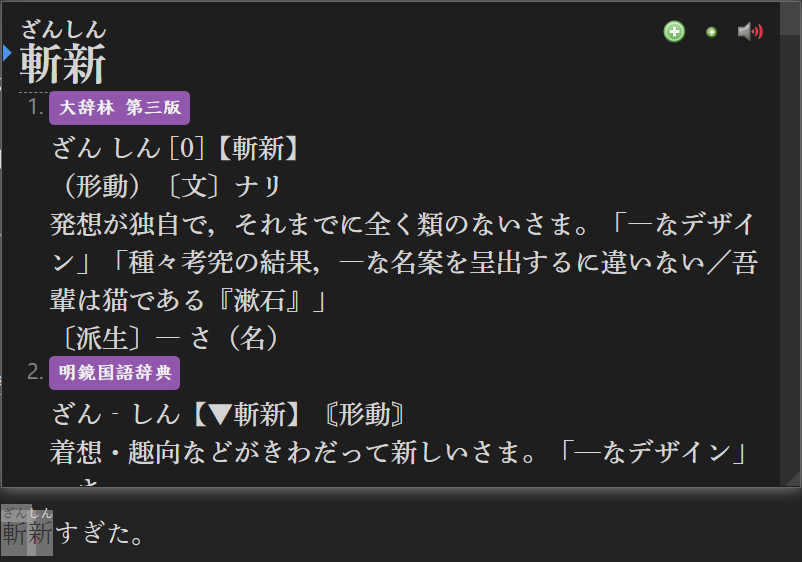
Yomichan is a browser extension that allows you to look up Japanese words on a webpage by holding Shift and hovering over it. It is supported by any Chromium or Firefox based browser. You can find out how to set up Yomichan here
Optimizing Yomichan Settings¶
First you need to ensure that Advanced options is enabled.

Second, we want to remove any and all scan delays because we will be making heavy use of this extension and wouldn't want to be slowed down by anything.
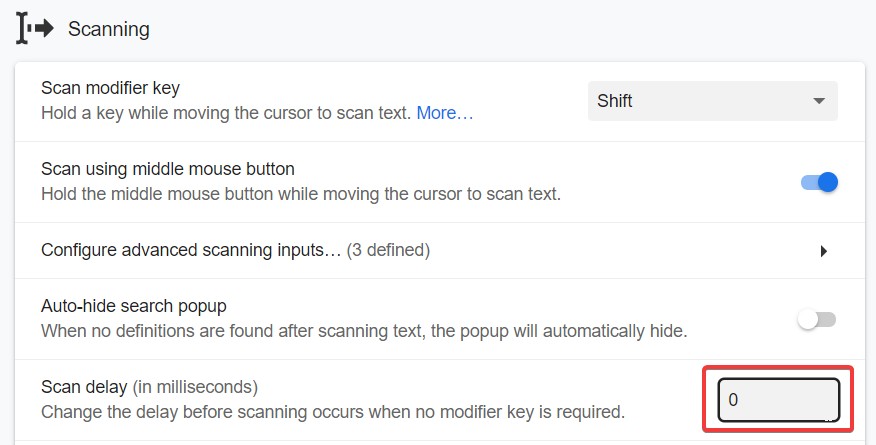
Now we will enable scanning within pop-ups, this is very important, as we want to be able to look up any words we don't know within a definiton.
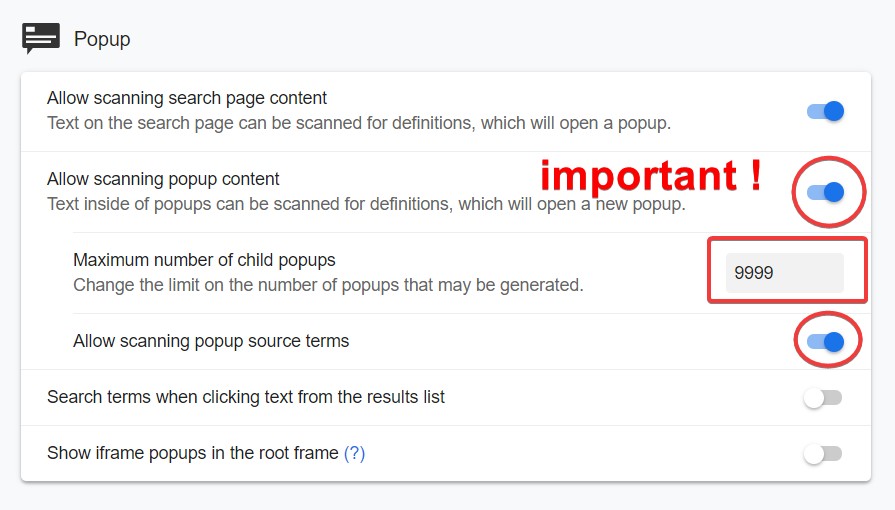
You may want to increase the size of your Yomichan pop up window because by default it is pretty small and will become a hindrance when using monolingual dictionaries. To make enough headroom to use Yomichan dictionaries comfortably we are going to edit the following settings.
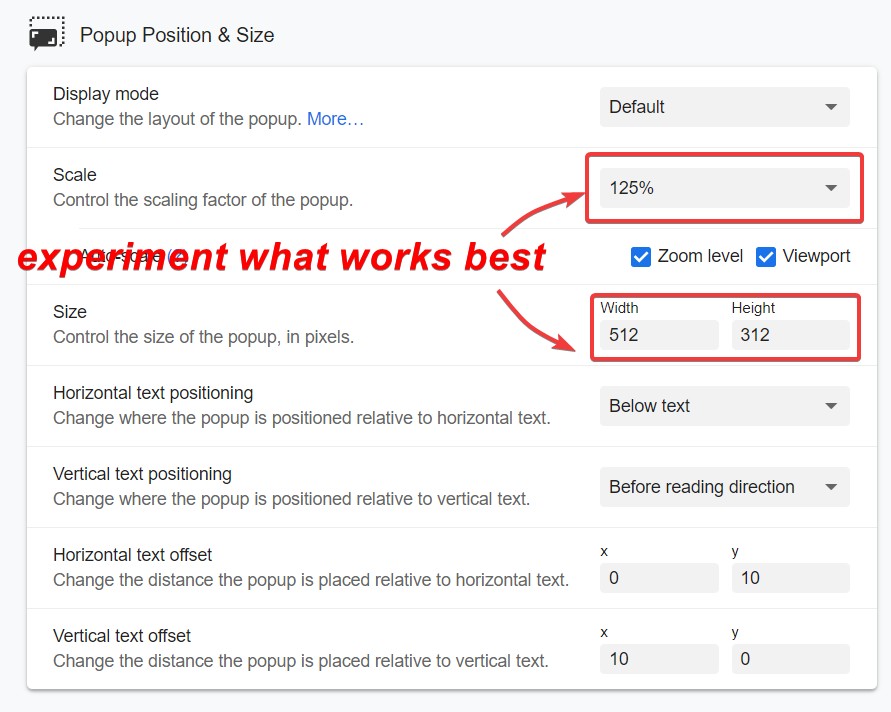
Here's how our pop up looks now:
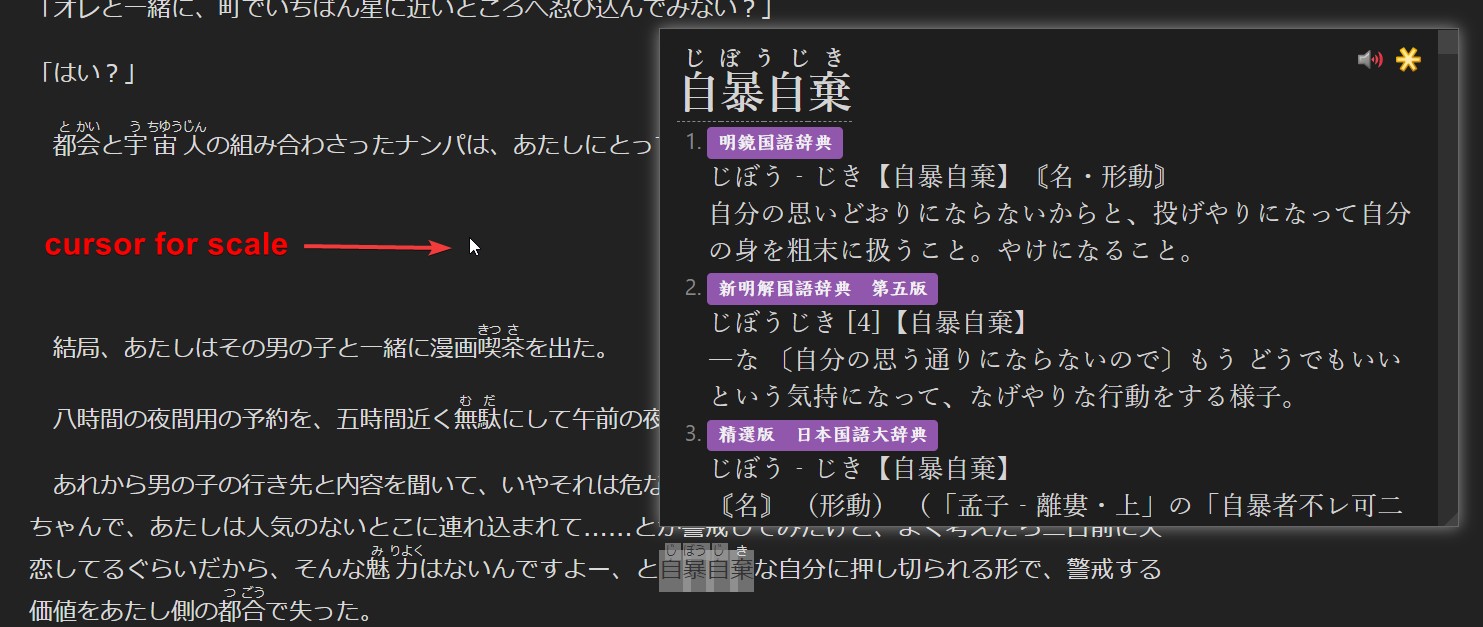
Next, if you want, you don't need to but I recommend it, enable automatic audio playback, so we know how to pronounce a word correctly the moment we look it up. Also add the extra audio source because surprisingly it adds extra audio!
You can also add the Forvo audio source in Yomichan. See Yomichan Setup Tutorial for more info.
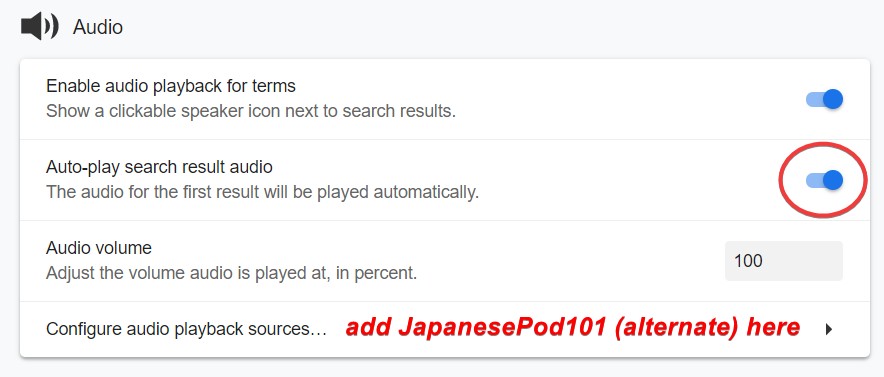
Update December 2021: You should also add a text replacement rule for words with kanji repetition marks, they usually do not appear in monolingual dictionaries unless you repeat the kanji itself. Example: 囂々 won't appear in most monolingual dictionaries but 囂囂 will.
Go to Settings -> Translation -> Custom Text Replacement Patterns and add the following rule:
Pattern: (.)々
Replacement: $1$1
I will touch on dictionaries in the next section.
Getting and using monolingual dictionaries¶
Again, I recommend you use monolingual dictionaries with Yomichan. I will talk about alternatives later.
You can find my dictionaries collection here: shoui Yomichan Dictionaries Collection
Before we continue, have a read on recommended dictionaries and what they are exactly.
Recommended Dictionaries¶
Here’s what I recommend for first time monolingual users:¶
旺文社国語辞典 第十一版
明鏡国語辞典
ハイブリッド新辞林
実用日本語表現辞典
新明解国語辞典 第五版
JMdict (English)
研究社 新和英大辞典 第5版
デジタル大辞泉
My personal order, for 100% monolingual coverage:¶
実用日本語表現辞典
大辞林 第三版
旺文社国語辞典 第十一版
デジタル大辞泉
明鏡国語辞典
新明解国語辞典 第五版
新明解国語辞典 第七版
精選版 日本国語大辞典
岩波国語辞典
広辞苑 第六版
ハイブリッド新辞林
故事ことわざの辞典
漢字源
新明解四字熟語辞典
学研 四字熟語辞典
漢字遣い参考
Every Dictionary Explained.¶
広辞苑 第六版 - 6th edition of Koujien, 2008. It is quite an authoritative dictionary in Japan, however it is not the most popular. This dictionary sorts its definitions from oldest to newest, which is not useful to learners of modern Japanese. Nevertheless, this dictionary has its own charm that I like.
大辞林 第三版 - an extension of the 3rd edition of the Daijirin, 2015. It has a wide assortment of words, expressions, proper nouns, grammar and connectives (actually more important than you think!). It is a a great all-rounder and personally my most used dictionary.
デジタル大辞泉 - Digital Daijisen, May 2021. The QUEEN of online dictionaries. This is the dictionary hosted on the Goo Dictionary, it has a lot of new words, expressions, images and kanji entries. The previous issue where the headword was missing has been fixed. Currently images won't work for Anki cards. (See Yomichan Issue #1741)
旺文社国語辞典 第十一版 - Oubunsha Kokugo Dictionary 11th Editon. Short name: Oukoku (旺国) is a monolingual dictionary published by Oubunsha in 2013. This dictionary's main selling point is how precise and easy to understand it is. And rightfully so; comparitively this dictionary has the most easiest to understand definitions. It explains the difference between kanji usages, 逢う, 会う etc. and is also really nice for grammar definitions. It is my #1 recommendation for people new to monolingual dictionaries. This version has images. But currently images won't work for Anki cards. (See Yomichan Issue #1741
旺文社国語辞典 第十一版 画像無し - No-image version of the above.
ハイブリッド新辞林 - Hybrid Shinjirin, 1998. This is based on the second edition of the Daijirin, but simplified. (actually was based on the 辞林21, which was also based on the Daijirin 2nd edition). It explains the difference between different kanji usages which is nice. My #3 recommendation for beginners.
精選版 日本国語大辞典 - Seisenban Nihonkokugodaijiten, 2016(?). Short name: Nikkoku (日国) is the biggest Japanese monolingual dictionary ever published, the physical version has multiple fascicles. This dictionary is the great for how much 漢語 it has, expressions, proper nouns, and specializes in classical Japanese. The example sentences look quite archaic because they are, they show the first known use of the word. This is the dictionary found on Kotobank . Not recommended at all for beginners but you'll love this when you're advanced.
明鏡国語辞典 - Meikyou Kokugo Dictionary is a Japanese monolingual dictionary published in 2002 and this is the first edition. What I like about the Meikyou is how it is easier to understand than dictionaries like the Daijirin and Daijsen, and also talks about the difference between kanji usage etc. 撃つ 打つ. It is also really nice for basic grammar definitions. This is my #2 recommendation for people new to monolingual dictionaries.
岩波国語辞典 - Iwanami Kokugo Dictionary, 6th edition, 2000. I have not used this dictionary enough to know it's strong points but it has a similar feeling to the Meikyou.
新明解国語辞典 第五版 - Shinmeikai Kokugo Dictionary, 5th edition, 1999. This dictionary is widely known for it's unique style of defining words. It also uses simple-er language for definitions, but the explanations can get まわりくどい, and thus hard to understand for learners. #4 recommendation for beginners.
新明解国語辞典 第七版 - Shinmeikai Kokugo Dictionary, 7th edition, 2017. Newer version of the above but can have troublesome formatting so I left the old version in the pack. This is the most popular dictionary in Japan.
実用日本語表現辞典 - Jitsuyou Nihongo Hyougen Jiten. This dictionary absolutely rocks! You need this! It will save your life!
新明解四字熟語辞典 - A yojijukugo dictionary from the Shinmeikai line of dictionaries.
学研 四字熟語辞典 - A yojijukugo dictionary published by Gakken.
故事ことわざの辞典 - A proverbs/idioms dictionary.
Weblio古語辞典 - A classical Japanese dictionary.
Continuation: Getting and using monolingual dictionaries¶
Let's continue. Import the set of dictionaries that best suits you in Recommended Dictionaries.
※ You can change dictionary priority so you can match the order by editing the number next to the dictionary. Higher the number = higher up in list.
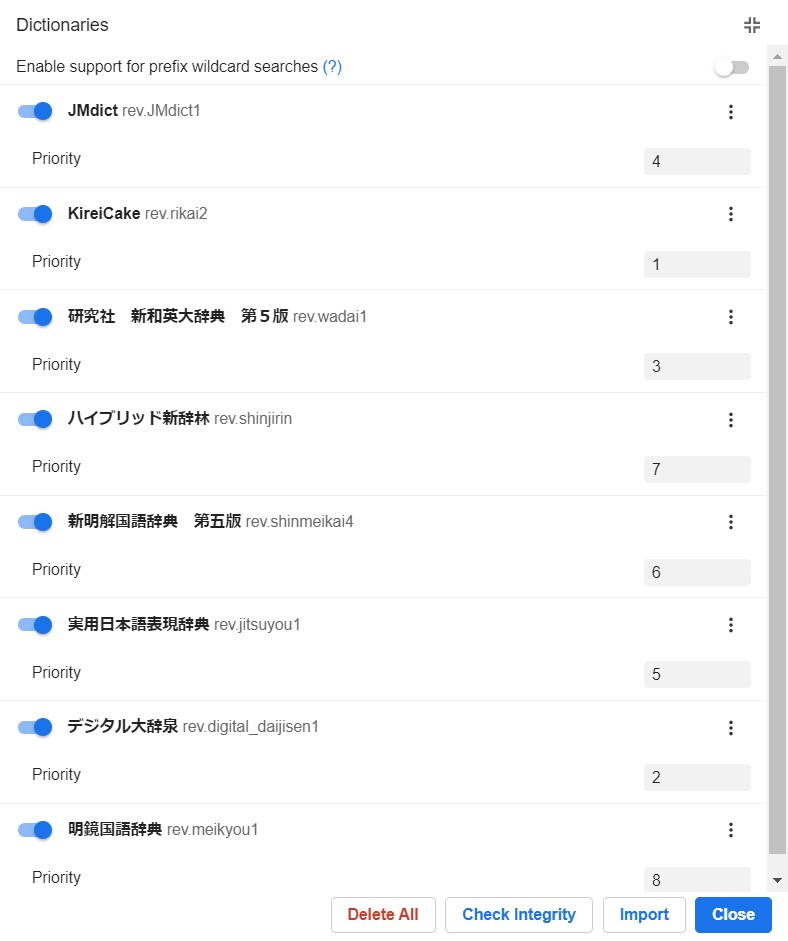
Why do you say use a lot of dictionaries?¶
You need to have a lot of dictionaries and have every one of them enabled because there will always be some words that are in some dictionaries and not in others. Take for example 禿同, that is only in 実用日本語表現辞典, and 夢海鼠, which is only in 日本国語大辞典. We want to use monolingual dictionaries as much as possible here. Another reason is that different dictionaries will describe a word in a different way, and in many cases you may not understand one dictionary's definition, but understand another.
But you would have to do a lot of scrolling to get to the next word?
You should use the keyboard shortcut Alt+Down
Alternatives¶
Online Dictionaries¶
Sakura-Paris Kojien Free Search
This site has all the major dictionaries, for free and online. You can’t view all the definitions at the same time though.
Weblio: https://www.weblio.jp/ (Uses デジタル大辞泉, 実用日本語表現辞典)
Goo: https://dictionary.goo.ne.jp/ (Uses デジタル大辞泉)
Kotobank: https://kotobank.jp/ (Uses デジタル大辞泉 and 精選版 日本国語大辞典)
Google: search “[word] 意味” e.g. “侮る 意味” (Uses 岩波国語辞典)
Offline Alternatives¶
You’re gonna be learning Japanese for a long time, so it is possible that your internet may go out when you’re tryna nihongo grind! So you’re basically screwed right? Nope!
You download anime right…?
Yomichan Offline¶
You can still use Yomichan offline. Here’s how.

That’s how.
Digital Dictionary Formats¶
You can see:
Japanese MDict (MDX) Dictionaries - newer, open source, up to date and lower in size. Encoded in UTF-8 which is a nice bonus for anyone wanting to convert these to other formats.
Japanese EPWING Dictionaries - old, extremely esoteric but popular in 電子辞書's from the 90's. Some are extremely bloated in file size. Encoded in EUC-JP which is a big spit in the face for anyone wanting to do any conversion with them.
Mobile¶
If you are using Android, you can download EBPocket, and load EPWING or MDict dictionaries into the app.
Typhon Reader is a great ebook reader for Japanese learners that supports EPWING dictionaries.
If you are using iOS, you can download EBPocket, and load EPWING or MDict dictionaries into the app using iTunes.
Approaching Monolingual Dictionaries¶
There’s a few ways to approach getting used to monolingual dictionaries. I’ll go through each one of them.
Primarily in the AJATT community, there’s this one piece of advice:
The “Throw away the bilingual dictionary forever, and start using the monolingual dictionary straight away!” Approach¶
This is something Khatzumoto of AJATT proposed.
I mean, if you read novels, this may be a pretty good approach, because you will already be familiar with the words, because novels generally just have more words than anime and manga. If you only watch anime and read manga, this may prove to be quite frustrating. When this piece of advice was put out, Yomichan didn’t exist. So people in that time would have found this piece of advice terrible and tiring to constantly look up everything in the definitions.
This isn’t a fundamentally flawed approach, I think it’s pretty good how it says “just read the dictionary more!”, because that’s exactly what you need to do.
I just disagree with throwing away the bilingual dictionary completely, because you still need it in the beginning of the monolingual transition.
The Morphman Approach¶
no
What you SHOULD do¶
How did I learn how to be comfortable with monolingual dictionaries? I read more. (novels, light novels, visual novels)
When I read more novels I got more used to written Japanese, and when I looked up words, they were in monolingual, so when I learned more words, I got better at using the monolingual dictionary. Huh? Yeah. It’s really that simple. Read more. Read the novel more = reading the dictionary more because you need a dictionary to read novels :)
>What did you do when you came across a word you didn’t know in the definition?¶
I looked it up with Yomichan. I tried reading the monolingual definition. If there were too many words I didn’t know in the definition, I just looked at the English definition (as a last resort) and moved on. You just need to keep doing this. REPETITION.
Read more books. You will get comfortable with the monolingual dictionary if you just read a lot. Yes. Read more. Read a lot. That’s all there is to it. Yomichan just makes the process easier, you don’t waste your energy manually searching, instead your energy goes into actually reading. That’s why I recommend using Yomichan.
>Soo… what’s the best way to approach monolingual?¶
Read more novels with a monolingual dictionary. I recommend reading novels on Itazuraneko using Yomichan.
>What if I don't like reading novels? I hate reading novels!¶
Find something you like. It can be a light novel or visual novel too you know. I "hate" novels in English, I have never tried to read more than 1 page of them, why do I "hate" them? Because I haven't experienced how good they actually might be, and I don't care really. But in Japanese, not only am I better at reading novels in Japanese, I also really enjoy reading novels in this language, I can't say the same for English. So even though you may despise novels in whatever your native language is, if you give it a shot (it will be difficult at first, as is everything), you may find yourself actually enjoying reading novels.
>shoui have you completely 卒業'd the bilingual dictionary?¶
Yes indeed. I haven't used the JMdict or anything since last year.
>But wouldn’t I be reading the dictionary more than the actual novel?¶
So what? It’s good that you are reading the dictionary more. Think of the dictionary as something FUN. It's fascinating in its own right.
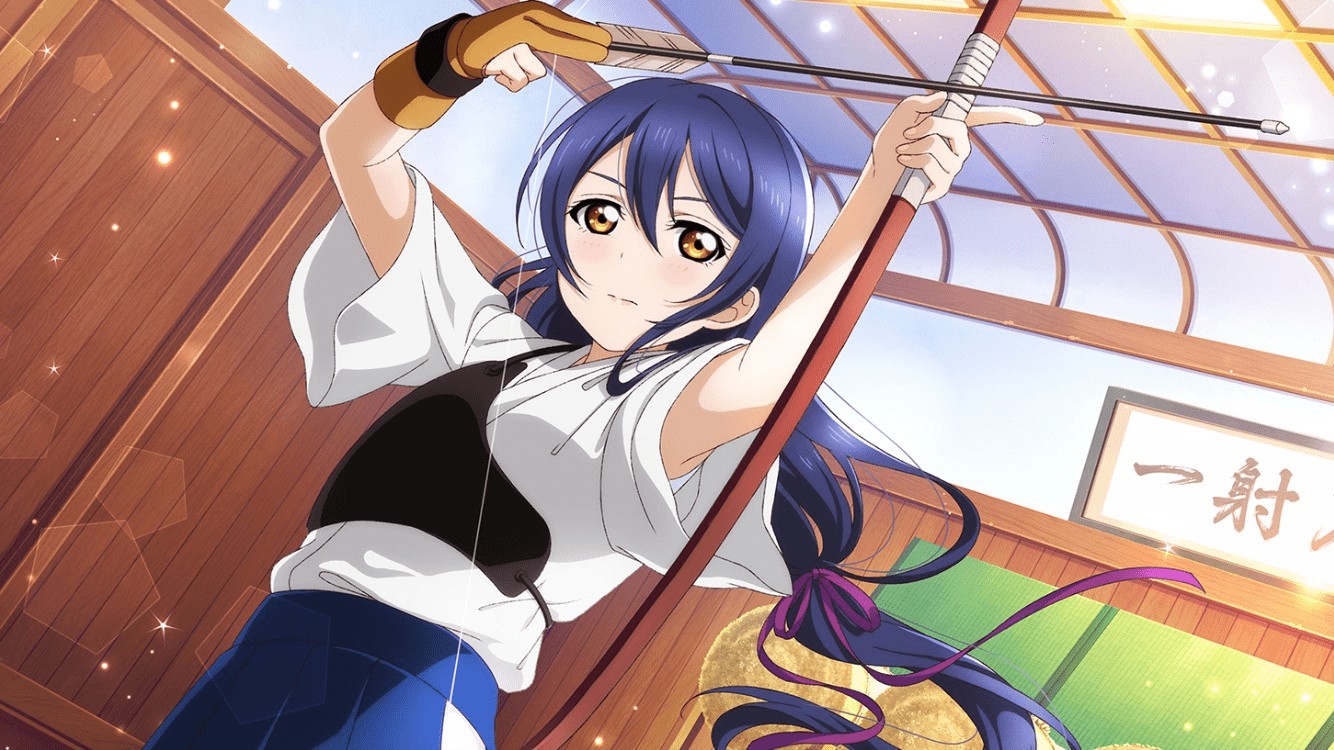
10 Important Tips and Tricks¶
(壱). Read at least 1 novel (it can be a light novel or visual novel) before going monolingual.
(弐). Try to experiment with what dictionary order is the best for you.
(参). If the word you look up with Yomichan is only in a bilingual dictionary, try doing a kana search for it, or a full kanji search (Alt+Insert to get to the Yomichan search page)
(肆). If you don’t understand the definition even if you looked up all the words, just look at/use the bilingual definition (last resort). You will get better at understanding when you use it more.
(伍). It is okay to check the bilingual definition to check that you’re getting the right basic idea.
(陸). Don’t worry about how much time it will take to “transition”
(漆). For monolingual Anki cards, just try to remember the gist of the definition. I tried to demonstrate this in Japanese FAQ
(捌). Try to look up words you already know, in the monolingual dictionary, this is just to try to get accustomed to the dictionary at first hand.
(玖). Forget looking up very concrete nouns such as animals in the monolingual dictionary, you are better off just using Google Images instead.
(拾). Don’t overdo yourself! If it's too hard, try to use the bilingual dictionary until you feel confident again!
Have fun immersing!
Found this useful? Consider supporting me on Patreon!
Walkthrough¶
Need help with monolingual definitions? Not sure what all the symbols mean? I have written a guide for my Patreon. (Basic tier and over)
